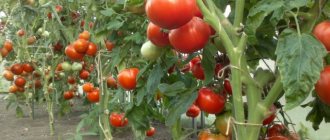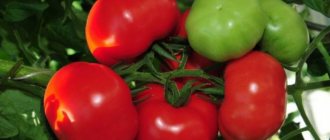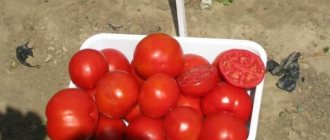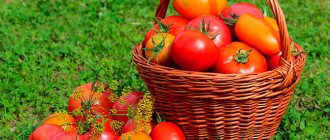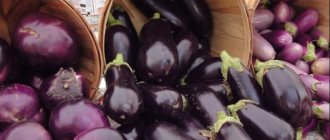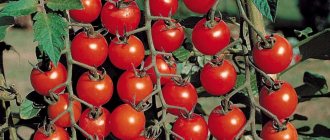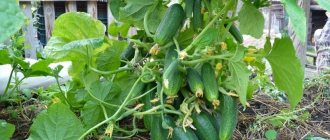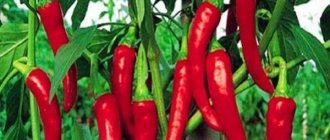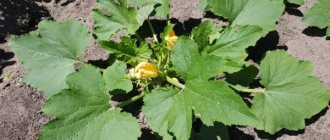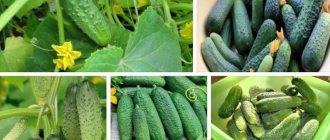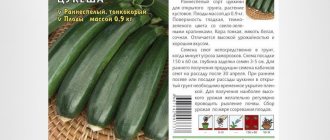- Updated: June 19, 2019
Most gardeners grow a variety of tomato varieties every year. However, experts recommend growing tomatoes for open ground that are resistant to late blight, which are least likely to die from disease. Therefore, before planting, it is advisable to become familiar with the important features of blight-resistant tomato species.
The danger of brown rot
Late blight is very dangerous for many plants of the nightshade family . Phytophthora infestans is the name of the causative agent of the disease, translated as “what kills the plant.” And this name is completely justified, since when this disease appears, the tomato bush begins to dry out, gray spots appear on the fruits, which gradually develop into rot with an unpleasant odor. The tomatoes become deformed and fall off.
If you do not take measures to treat the plant against late blight, you can lose your entire tomato harvest.
How dangerous is late blight for tomatoes and what causes it?
Late blight (late blight) is a dangerous fungal disease. Translated from Latin, the name of the fungus “phytophthora” is translated as “destroying the plant.” In addition to tomatoes, the fungus does not spare strawberries, potatoes, and buckwheat.
Reference. Plants have stomata, through which late blight enters the body. After this fungal spore grows into the tissue - from that moment on, the plant is infected. Gardeners notice signs of the disease by mid-summer - brown spots and brown ulcers appear on tomato leaves.
The disease is transmitted through infected tubers, seeds, and soil. The disease develops especially quickly in conditions of high humidity. If there is a long period of heat and drought, this is good, since the fungal spores may die.
Tomatoes resistant to late blight and diseases for greenhouses
There are no tomatoes that can be 100% classified as free from late blight; breeders have simply developed hybrids that yield much earlier than the disease begins to develop. Let's consider the main hybrid varieties with resistance to late blight, which are recommended for planting in closed ground.
Gardener
Early ripening, semi-determinate variety. Bush up to 2 meters, 100 days pass from the first shoots to harvest. To get a good harvest, you need to form a bush with 2 stems, the remaining layering is removed, and the vines are tied up.
With one bush of Ogorodnik variety tomatoes, with good care, you can get up to 7 kg of fruit or 14 kg per square meter.
Long-term fruiting begins in mid-summer and continues until the first frost. The weight of the fruits is up to 360 grams, and they have excellent taste and aroma. The fruits are stored for a long time and tolerate transportation well. The Ogorodnik variety has strong immunity to late blight .
Gypsy
Salad, high-yielding, mid-season hybrid, with high seed germination. You can try the first tomatoes 110 days after sowing. The bush is not large, determinate in appearance, grows no more than 1.3 meters in height, and does not require support or garter.
To obtain a large number of fruits of the Gypsy variety from one bush, it needs to be formed into three stems.
Fruiting is cluster, 5 tomatoes on one cluster. Fruits weighing 180 grams with a sweet and sour taste. tomatoes tolerate long-term storage and transportation well. The culture has strong immunity to many diseases.
Academician Sakharov
Mid-season, tall variety with uniform fruiting on the 90th day after germination. The Academician Sakharov crop bears fruit very amicably , and the fruits weigh up to half a kilogram.
The bush should be formed into 2 stems with tying and pinching. The variety is salad, not suitable for canning.
It is difficult to store as the fruits are very juicy. Resistant to late blight and other viral diseases.
Resonance
Early ripening, hundred-day hybrid. Tolerates extreme heat and drought well. The bush is not large, growing up to one and a half meters in height. Universal tomatoes weighing 300 grams, with a pleasant taste. It has not only good shelf life and transportation, but also resistance to most diseases including late blight.
Soyuz 8 F1
An early ripening hybrid, with a ripening period of 100 days. The bush variety Soyuz 8 F1 rarely grows above a meter .
The Soyuz 8 F1 variety is characterized by high yield; up to 21 kg of fruit can be obtained per meter, subject to optimal care.
It is noteworthy that the fruits weighing 125 grams ripen very quickly; in the first 2 weeks of fruiting, the variety produces 60% of the harvest. The fruits are very dense, so they can withstand transportation without loss and are stored well. The hybrid is resistant to many diseases.
Other varieties
- Rose of Wind.
- Snowdrop.
- Alaska.
- Snow fairy tale.
- Alpatyeva 905.
- A little prince.
- Budenovka.
For closed ground
Modern hybrids with complex disease resistance exhibit the greatest resistance to late blight.
Zhenaros F1
A mid-early Dutch hybrid, tolerant to late blight at the genetic level, bears fruit well in greenhouses near Moscow. Plants are not damaged by nematodes, viruses, verticillium blight, cladosporiosis, fusarium blight. Medium-sized, weakly leafy bushes set fruit even at elevated temperatures and other extreme conditions. The tomatoes are round-flat, very dense, bright scarlet, weighing 200-280 g. The hybrid is characterized by excellent transportability. Productivity is high.
Red Army F1
Important features of this early-ripening Russian hybrid are good resistance to late blight and decent yield (about 20 kg per 1 sq. m). The stem is strong, standard, not too long (one meter high, semi-determinate type), but due to the close internodes, at least 5-6 inflorescences are formed on it. The average fruit size is 170 g. Scarlet tomatoes are distinguished by their increased density and are stored ripe for about 20 days, without losing quality and maintaining their presentation.
Magnus F1
An early ripening tomato of Dutch origin resists late blight fungus at the gene level. The hybrid is not afraid of other harmful organisms - viruses, nematodes, verticillium, fusarium. Fruitful plants have increased cold resistance. On medium-sized bushes, red fruits with strong shiny skin and dense pulp ripen together. The shape of the tomatoes is spherical, with slight ribbing; the average weight is 150 g. Ripe tomatoes are stored for one and a half to two weeks.
Matissimo F1
The newest Dutch beef tomato has comprehensive resistance to tomato diseases. Amicable early ripening occurs even with a lack of heat and light. Rich red glossy tomatoes fill up to 250 g and never burst. Transportability and productivity are at the highest level.
Blueberry
is a non-hybrid variety of American selection with burgundy-purple fruits. Indeterminate bushes are not damaged by diseases. It takes about three months from germination to ripening of tomatoes. Elongated clusters bear 6-8 round tomatoes weighing 150-180 g. The dark pulp, rich in anthocyanins, has a unique sweet-spicy taste and bright aroma.
Previous
TomatoesDescription, characteristics and features of growing Volgograd early ripening tomato
Next
TomatoesDescription, characteristics and cultivation of the Balcony Miracle tomato variety
Which early ripening varieties have the strongest immunity?
Phytophthora - can settle in the ground, on garden tools, and it is almost impossible to evict it , but it is possible to plant varieties of tomatoes that are immune to this parasitic fungus.
Tatiana
Indeterminate, hybrid with medium growing season, with a bush height of more than three meters.
Tomatoes of the Tatyana variety begin to ripen 100 days after harvesting. Up to 7 fruits weighing 400 grams are born on 1 cluster.
The fruits are very attractive, red in color and slightly flattened in shape. The high-yielding variety can produce more than 8 kg of fruit from one bush.
Cardinal
Tomatoes of the Cardinal variety are tall, indeterminate, the bush reaches 2 meters . Early ripening, produces a harvest 80 days after the appearance of the first sprouts.
The fruits are very large, weighing 800 grams, and up to 11 kg are obtained from one bush. Despite the meatiness of soybeans, the tomato stores very well.
The culture is resistant to late blight and infections.
Black
A tall, mid-season hybrid that is rarely attacked by fungal diseases. bush height 2 meters or more.
The Black variety begins to bear fruit on the hundredth day after germination. This variety is notable for the purple color of its tomatoes.
From one bush of the Black variety you can collect up to 8 kg of fruits weighing 170 grams each . It tolerates transportation and long-term storage well.
Carlson
A compact, tall, indeterminate tomato that begins to set fruit 80 days after germination.
The productivity of the Carlson variety is high, up to 10 kg per bush, while each tomato weighs 200 g. The bush needs to be shaped and tied up.
The plant resists many infections and fungal diseases well.
De Barao
The De Barao variety is an indeterminate hybrid with a bush height of more than 2 meters . Each bush produces up to 10 clusters with 6 fruits weighing 300 grams. The variety is mid-season, hundred days old, universal.
From one bush you can get more than 10 kg of harvest, provided optimal conditions are created.
It has good shelf life and does not lose its presentation during transportation. The hybrid is resistant to many diseases.
Other types
- Black bunch F1.
- Black pear.
- Union 8.
- Lark.
- Karotinka.
- Tsar Peter.
Popular varieties for open beds
The causative agent of late blight is a fungus that affects not only tomatoes, but also other vegetable crops of the nightshade family.
It is not always possible to detect the first signs of the disease, since the inside of the leaves is affected and a whitish coating appears. In a couple of days, the white coating turns brown, and the entire plant, including the fruits, becomes covered with dark spots. A dark seal first appears on the tomatoes, which grows every day, and as a result, the entire fruit darkens and begins to smell unpleasant.
Phytophthora spores live everywhere: in the soil, on the tops of last year’s harvest, and on garden tools. In dry, clear weather they are dormant. But as soon as the rainy weather drags on, the harmful activity of the fungus becomes more active.
What tomatoes are not afraid of late blight? Many years of experience of vegetable growers and specialists will help you answer this question. If we talk about which varieties and hybrids show resistance, then the latter win . It is the hybrids that are bred by breeders to obtain the best characteristics, including resistance to brown rot.
Which varieties of tomatoes are not subject to rot can only be understood by growing the crop for several years. Tomato varieties resistant to late blight are recognized by experienced vegetable growers, they are unpretentious to weather and care, and are resistant to many other viruses and bacteria.
Openwork F1 will become a real treasure for gardeners. It is distinguished by an abundant harvest and withstands not only late blight, but also many other common diseases. It stretches up to 78 cm. Mid-early crop - the harvest will be ready for consumption after 100 days. The fruits are round-flattened and red in color, weighing approximately 250 g.
The F1 doll is a hybrid and therefore has good characteristics. This is an early variety, fruit ripening occurs after 87 days. The bush is small, about 60 cm. It requires tying, as the fruits are heavy - about 280 g, and removal of side branches. The color of ripe tomatoes is red-orange.
Hybrid Captain F1 begins to ripen very early, after 80 days. An adult bush does not exceed 70 cm in height. The red fruits have an even, round shape, their weight is 120 g.
The riddle has compact bushes that are not afraid of fungal and viral infections. The height of the central stem is no more than 50 cm. The fruits ripen on tassels of 5 pieces weighing up to 75 g. They begin to ripen already on the 85th day, turning a bright red color.
Mikado grows up to 90 cm and is characterized by medium boundaries of fruit formation. A ripe, red-scarlet harvest can be harvested after 115 days. Step-sonning is required. The fruits weigh approximately 250 g.
Intuition F1 shows unpretentiousness to weather changes and rarely suffers from late blight. It can grow up to 190 cm, so it is necessary to tie up and cut off the side branches. The variety is characterized by average fruit ripening limits: tomatoes begin to turn red after 115 days. Weight reaches 105 g.
Tomatoes of the Lakomka variety are not affected by late blight. The growth of the plant does not exceed 62 cm in height. They begin to ripen after 82 days. The tomatoes are red-raspberry in color and have a round shape.
Domestic low-growing hybrids
Modern tomato varieties are resistant to the disease. There are tomato varieties that can be grown without staking and bush formation .
Dubrava
This is a low-growing variety; the height of the bush rarely reaches more than 60 cm.
The first fruits of the Dubrava variety can be harvested 80 days after the seedlings appear.
The variety is high-yielding and does not require staking or pinching. Since the plant is early ripening, it does not suffer from late blight during the growing season.
Resonance
The hybrid variety Resonance is short, bush height 1.2 m . Requires the formation of a bush, so during the entire growing season it forms lateral layers.
Plants harvest from the Resonance variety in 90 days.
It is worth noting that the crop easily tolerates a lack of moisture and is not susceptible to common diseases of the nightshade family.
Dwarf
The Gnome tomato variety is universal, hundred-day-old, low-growing . The bushes are small, compact, only 45 cm high. From one plant you can get 3 kg of tasty, aromatic fruits, weighing 60 grams each.
Orange miracle
An early ripening tomato variety, the first tomatoes can be tasted already 90 days after germination. The weight of one fruit is 400 grams. Grows well and bears fruit with a lack of moisture. Excellent resistance to late blight and infections.
Perseus
Early ripening, low growing (70cm), universal variety. The weight of one tomato is 120 grams; the harvest can be obtained 90-100 days after germination. The Perseus variety is immune to many fungal and infectious diseases .
What else?
- A little prince.
- Grotto.
- Oak.
- White filling.
- Berry.
- Orange heart.
- Lights of Moscow.
Features of choosing tomato seeds for the Moscow region
When choosing tomato seeds for growing in the Moscow region, you need to proceed from the following climate features of this area:
- sudden changes in temperature;
- early autumn frosts (can begin in the first ten days of October);
- increased air humidity (above 70%).
In such conditions, many varieties of tomatoes will not grow and bear fruit well, in particular, tomatoes with late ripening periods.
Therefore, experts recommend growing early or mid-early varieties of this vegetable crop in greenhouses in the Moscow region - and no more than 90 days should pass from the appearance of the first shoots to harvest. Typically, summer residents in the Moscow region first grow tomato seedlings at home or in greenhouses, which are transplanted to a permanent place when 5-6 permanent leaves appear on the plants, and the air temperature in the region remains stable at +15+16⸰С.
Typically, such weather conditions are established in the second ten days of May, and seeds for seedlings should be planted approximately 60 days before transplantation - in the second ten days of March.
Preventive measures
It is very difficult to treat tomatoes from late blight; sometimes no methods or preparations help maintain good yields.
Therefore, it is better to apply preventive measures that will help eliminate infection .
- The first method of prevention can be called growing tomatoes in greenhouses, since it is easier to create special conditions under which the disease will not spread, and the tomatoes will grow strong and healthy.
- The greenhouse must have a ventilation system with constant ventilation.
- The soil in the greenhouse must be disinfected before each planting, since late blight spores may be present in the soil.
- When planting tomatoes in open ground, you need to choose a ventilated place, and watering should be moderate, otherwise late blight will quickly wake up and begin to act.
It is worth noting that there is no need to overfeed plants with organic matter, as it can also cause infection.
- Watering is carried out only at the root, since in cloudy weather moisture can linger under the leaves of the plant, which will cause fungal infection. Watering is carried out early in the morning.
- If you notice dark spots on the plant, tear it out of the ground without regret and burn it, this way you will save your harvest.
Criterias of choice
As criteria for selecting varieties resistant to late blight disease, we highlight the following:
- early fruiting periods;
- resistance to temperature changes;
- unpretentiousness.
The list of varieties includes a lot of low-growing tomatoes that can be grown in open ground. They do not need pinching and produce good harvests even in the most difficult weather years.
The question of which varieties to take: foreign selection or domestic is debatable. There is also no consensus here, since some people grow “Dutch” hybrids very successfully and are very pleased, others only like Russian zoned varieties.
We also noted indeterminate varieties and hybrids, popular among gardeners near Moscow, choosing only mid-season zoned varieties, but characterized by good yield.
Choose, experiment, try!
Varieties that are not afraid of late blight for Belarus
Not all tomatoes with resistance to late blight grow well in Belarus due to the climate. However, there are several varieties that are suitable for this country:
- Evgenia. Belarusian farmers prefer to grow Eugenia, since its bushes are rarely infected with fungal diseases. The variety is also distinguished by high-quality fruits that do not crack after picking and are suitable for pickling.
- Aurora. Gardeners recommend planting Aurora if tomatoes are needed for preparing fresh salads. The taste of ripe tomatoes will make any vegetable dish much tastier. It is better to plant Aurora in greenhouses, where the temperature will remain above zero.
- Admiral. Indeterminate tall plant with bushes 2-3 meters high. The Admiral's harvest is stored for a long time and can be transported over long distances without problems.
Causes of late blight
Fungal disease develops quickly in the garden in cool, cloudy and rainy weather. Greenhouse plants are less susceptible to late blight. In dry sunny weather, disease of the entire plantation is unlikely. Having noticed a tomato bush affected by late blight, it is removed. Summer mornings, at the end of July and August, drops in temperature and fog, followed by daytime heat, contribute to the spread of spores. In damp weather from the beginning of summer, late blight develops earlier. Spores are introduced from a bed of diseased potatoes or from other sources.
Possible causes of late blight:
- application of nitrogen fertilizers in excess of the norm, which leads to thickening of plantings;
- lack of iodine, potassium or manganese in the soil;
- untimely weeding of weeds that interfere with the free flow of air in the garden;
- watering above normal or by sprinkling;
- The area is located in the shade.
It is not so easy for late blight spores to penetrate into a greenhouse, but the appearance of the disease indoors is almost always a death sentence for all plants. Thanks to humidity and heat, late blight quickly affects leaves and fruits.
Warning! A greenhouse with a wooden frame is dangerous for replanting tomatoes the following year if the plants have suffered from late blight. Spores remain in wood for a long time and are not afraid of heat or frost.
Specifics of cultivation and care
In order for tomatoes to bear fruit well, you need to familiarize yourself with the nuances of growing and caring for them.
It is very important that the tomato seeds germinate quickly and the first shoots appear. To speed up the germination of the bed with planted vegetables, it is necessary to water it periodically. At first, the holes are filled with water 4-5 times a week, but after the emergence of seedlings, watering is reduced to three times. Experienced farmers advise watering seedlings at the roots, since water getting on the leaves has a negative impact on the health of the plants.
Also, when caring for tomatoes, you will have to feed them with fertilizers. They are needed to saturate the soil with the nutritional components that seedlings need.
The following fertilizers are added to the soil:
- Nitrogen. They are added to accelerate the growth of green mass and yield formation. You should not add too much nitrogen to the soil, as this will cause the fruits to ripen more slowly.
- Potassium. Fertilizers that contain potassium cleanse tomatoes of nitrates and make them more healthy.
- Boron with magnesium. These fertilizers are added to the soil at the time of flowering. Due to a lack of magnesium or boron, flowers on bushes quickly fall off and productivity deteriorates.
Seeds and seedlings
The seeds may contain spores of pathogenic fungi, so before planting, the seeds are soaked in a pink solution of manganese for 20 minutes. After washing and drying the seeds, you can sow. The purchased seed material may be green, pink or blue, in which case the manufacturer has already carried out disinfection.
Calcination of the soil is one of the effective methods of preparing it for planting. The soil is poured onto the baking sheet in a layer of no more than 6 centimeters and calcined at a temperature of 70-80 degrees for about 30 minutes. Used containers, boxes, glasses are washed with laundry soap or diluted chlorine bleach.
Weakened plants are among the first to be affected by late blight. To prevent this from happening, it is necessary to grow healthy, strong seedlings. The planted seeds are watered with warm water. Shoots appear on days 3–7 depending on the variety. Tomatoes peak when two true leaves appear.
Two weeks before planting in the garden, the tomatoes are hardened off. A loggia, balcony or open window is suitable for this. The average air temperature for hardening is 15–18 degrees.
Tomatoes Little Prince
An early ripening tomato variety that ripens 90-95 days after planting. Tomatoes, as the name suggests, are small, 40-45 g, round in shape. The fruits are considered universal and are great for eating raw and for canning. The variety is characterized by a stable harvest that ripens at the same time, and excellent taste.
Tomatoes Gnome
A universal early-ripening plant that bears fruit in at least 95 days. The height of the bushes does not exceed 45 centimeters. The fruits are round and red, with two or three chambers, weighing from 50 to 60 grams. Good yield (up to three kilograms per plant), no need for pinching.
Latest articles about gardening
All about animal mole rats: what do they eat, do they have eyes, what does it look like, babies, photos
Top 10 long-flowering perennials for the garden
How to care for croton, types with photos, replanting, feeding, diseases
Tomatoes Academician Sakharov
The variety received its title of “academician” for a reason. Firstly, its distinctive feature is its tallness, and secondly, its very large fruits. The indeterminate shrub grows up to 2.5 m in height, and the fruits that ripen on it weigh up to 0.5 kg each. Bright red tomatoes with tender and juicy flesh will complement any table, and the sauce or ketchup made from them will not leave even the most notorious gourmet indifferent. The harvest can be harvested within 105-115 days after planting.
Also, varieties that are not subject to late blight include:
- Late blight resistant. That’s what it’s called and it lives up to its name. But its fruits are not very tasty, and the yield is low;
- Tsar Peter. This is a mid-season variety; it rarely suffers from this type of mycosis;
- Blizzard. The variety is late, but it is extremely rarely affected by any tomato ailments, not just fungal ones;
- New Year. Hybrid, therefore little susceptible to fungus and its negative effects. It can be stored for a very long time and remains tasty.
As is easy to understand from the names, most of them were created specifically for cool and short summers and at least partial cultivation under film or in a greenhouse. Therefore, these varieties may not have particularly high yields, and not all of them are good for long-term transport. But this is perfectly compensated by decent taste and the ability to grow tomatoes in places where just a few decades ago this was considered impossible.
